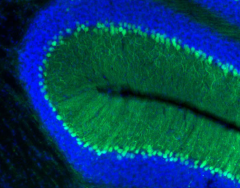Topics
Regulating gene regulatory regions offers a novel mechanism to control ATXN1 levels

People with a rare genetic neurodegenerative disease known as spinocerebellar ataxia type 1 (SCA1) usually have progressive problems with movement, including loss of coordination, and balance (ataxia) and muscle weakness. They typically survive 15 to 20 years after symptoms first appear.
“SCA1 is one of the adult-onset neurodegenerative diseases for which we know the genetic cause, in this case the gene ATXN1,” said first author Larissa Nitschke, doctoral candidate in the lab of Dr. Huda Zoghbi at Baylor College of Medicine and the Jan and Dan Duncan Neurological Research Institute at Texas Children’s Hospital. “When we identified the gene, we learned that mutations can cause the ATXN1 protein to remain in cells longer than normally. This is bad news for neurons as too much ATXN1 leads to their death.”





